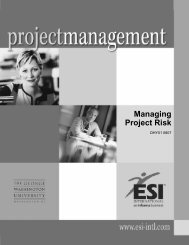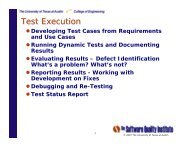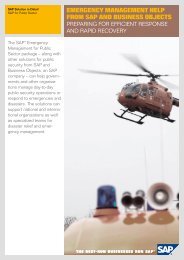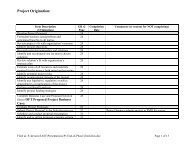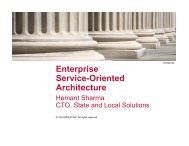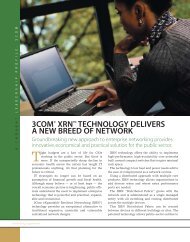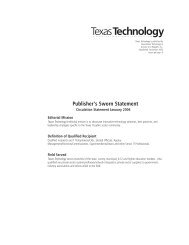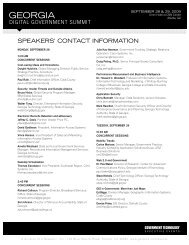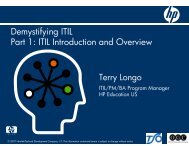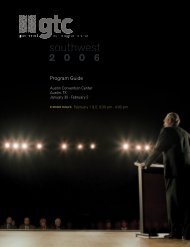Unify Your Backup and Recovery Strategy with LiteSpeed® for SQL ...
Unify Your Backup and Recovery Strategy with LiteSpeed® for SQL ...
Unify Your Backup and Recovery Strategy with LiteSpeed® for SQL ...
Create successful ePaper yourself
Turn your PDF publications into a flip-book with our unique Google optimized e-Paper software.
<strong>Unify</strong> <strong>Your</strong> <strong>Backup</strong> <strong>and</strong> <strong>Recovery</strong> <strong>Strategy</strong><br />
<strong>with</strong> LiteSpeed ® <strong>for</strong> <strong>SQL</strong> Server<br />
<strong>and</strong> LiteSpeed ® Engine <strong>for</strong> Oracle<br />
Written by<br />
Tom Sager,<br />
DBA team leader<br />
E. ON U.S.<br />
Technical Brief
© 2009 Quest Software, Inc.<br />
ALL RIGHTS RESERVED.<br />
This document contains proprietary in<strong>for</strong>mation, protected by copyright. No part of<br />
this document may be reproduced or transmitted <strong>for</strong> any purpose other than the<br />
reader's personal use <strong>with</strong>out the written permission of Quest Software, Inc.<br />
WARRANTY<br />
The in<strong>for</strong>mation contained in this document is subject to change <strong>with</strong>out notice.<br />
Quest Software makes no warranty of any kind <strong>with</strong> respect to this in<strong>for</strong>mation.<br />
QUEST SOFTWARE SPECIFICALLY DISCLAIMS THE IMPLIED WARRANTY OF THE<br />
MERCHANTABILITY AND FITNESS FOR A PARTICULAR PURPOSE. Quest Software<br />
shall not be liable <strong>for</strong> any direct, indirect, incidental, consequential, or other<br />
damage alleged in connection <strong>with</strong> the furnishing or use of this in<strong>for</strong>mation.<br />
TRADEMARKS<br />
All trademarks <strong>and</strong> registered trademarks used in this guide are property of their<br />
respective owners.<br />
World Headquarters:<br />
5 Polaris Way<br />
Aliso Viejo, CA 92656<br />
e-mail: info@quest.com<br />
Please refer to our Web site (www.quest.com) <strong>for</strong> regional <strong>and</strong> international office<br />
in<strong>for</strong>mation.<br />
Updated—February 16, 2009<br />
TBD-Unified-<strong>Backup</strong><strong>Recovery</strong>-US-AG
CONTENTS<br />
INTRODUCTION ..........................................................................................1<br />
CHALLENGES OF DATABASE MANAGEMENT:<br />
DATA GROWTH AND DATA SECURITY..........................................................2<br />
DATA GROWTH............................................................................................. 2<br />
SECURITY AND COMPLIANCE ............................................................................. 3<br />
DEVELOPING A BACKUP AND RECOVERY STRATEGY .....................................4<br />
REQUIREMENTS ............................................................................................ 4<br />
BACKUP AND RECOVERY METHODS...................................................................... 4<br />
LITESPEED TO THE RESCUE.........................................................................5<br />
LITESPEED ADVANTAGES ................................................................................. 6<br />
ENCRYPTION LEVELS ...................................................................................... 6<br />
SETTING THE ENCRYPTION AND COMPRESSION LEVELS .............................................. 7<br />
<strong>SQL</strong> Server............................................................................................. 7<br />
Oracle ................................................................................................... 9<br />
OBJECT-LEVEL RECOVERY .............................................................................. 10<br />
<strong>SQL</strong> Server........................................................................................... 10<br />
Oracle ................................................................................................. 11<br />
USING LITESPEED: REAL-WORLD EXAMPLES ............................................ 12<br />
NEED BOTH COMPRESSION AND ENCRYPTION BUT BACKUP WINDOW IS SHORT ............... 12<br />
NEED COMPRESSION AND HAVE PLENTY OF TIME ................................................... 12<br />
NEED SPEED MORE THAN ANYTHING ELSE ........................................................... 12<br />
SUMMARY ................................................................................................. 13<br />
ABOUT THE AUTHOR ................................................................................. 14<br />
ABOUT QUEST SOFTWARE, INC. ................................................................ 15<br />
CONTACTING QUEST SOFTWARE....................................................................... 15<br />
CONTACTING QUEST SUPPORT......................................................................... 15<br />
i
INTRODUCTION<br />
Technical Brief<br />
Database backup <strong>and</strong> recovery is becoming more difficult <strong>and</strong> more complicated. Two<br />
factors are putting a “double whammy” on today’s IT shops like never be<strong>for</strong>e: (1) the<br />
unabated explosion in data growth <strong>and</strong> (2) the ever-increasing need <strong>for</strong> data<br />
security. Further complicating these challenges is the fact that most IT shops use<br />
more than one database management system.<br />
As a database administrator (DBA) in a multi-plat<strong>for</strong>m shop, I have responsibility<br />
<strong>for</strong> developing <strong>and</strong> managing a database backup <strong>and</strong> recovery strategy that covers<br />
both Oracle <strong>and</strong> <strong>SQL</strong> Server while addressing our continued data growth <strong>and</strong> need<br />
<strong>for</strong> security. This technical brief explains how I use Quest’s LiteSpeed ® <strong>for</strong> <strong>SQL</strong><br />
Server <strong>and</strong> LiteSpeed ® Engine <strong>for</strong> Oracle to effectively manage my fast-growing<br />
databases <strong>and</strong> comply <strong>with</strong> security requirements.<br />
1
<strong>Unify</strong> <strong>Your</strong> <strong>Backup</strong> <strong>and</strong> <strong>Recovery</strong> <strong>Strategy</strong> <strong>with</strong> <strong>LiteSpeed®</strong><br />
<strong>for</strong> <strong>SQL</strong> Server <strong>and</strong> <strong>LiteSpeed®</strong> Engine <strong>for</strong> Oracle<br />
CHALLENGES OF DATABASE MANAGEMENT: DATA<br />
GROWTH AND DATA SECURITY<br />
Data Growth<br />
Everyone knows that the volume of data managed by IT shops is growing, but by<br />
how much? To find out, I have been tracking the size of the production database<br />
servers in my company. Figure 1 shows the growth of one group of servers:<br />
Figure 1. Recorded database growth<br />
Plotting that data on a curve reveals the projected growth of those servers <strong>for</strong> the<br />
next few years:<br />
2<br />
30<br />
25<br />
20<br />
15<br />
10<br />
5<br />
0<br />
Projected Production Database<br />
Growth<br />
2000 2005 2010 2015<br />
Figure 2. Projected database growth<br />
Terabytes<br />
Expon. (Terabytes)
Technical Brief<br />
Even I was surprised at the curve of that trend line! I knew we had more data, but<br />
I didn’t realize it was that much more. The data growth we are experiencing truly is<br />
exponential (an often overused term). If the projection is correct, I will be faced<br />
<strong>with</strong> backing up close to 30TB of databases <strong>with</strong>in the next three years.<br />
Security <strong>and</strong> Compliance<br />
DBAs not only need to manage more data but we must also meet an increasing<br />
number of complex compliance <strong>and</strong> security st<strong>and</strong>ards. For example, I don’t yet<br />
encrypt all database backups, but that is clearly going to be a requirement in<br />
the future.<br />
Moreover, like many DBAs, I must manage multiple groups of databases <strong>with</strong> different<br />
auditing, security, <strong>and</strong> compliance requirements. In particular, I have “in-scope”<br />
applications that are subject to security requirements beyond the norm, <strong>and</strong> this list of<br />
in-scope applications is growing every year. Instead of treating the in-scope<br />
applications in a special way, I would prefer to simply subject all applications to the<br />
requirements of most secure application, <strong>and</strong> encrypt them all to the same st<strong>and</strong>ard.<br />
3
<strong>Unify</strong> <strong>Your</strong> <strong>Backup</strong> <strong>and</strong> <strong>Recovery</strong> <strong>Strategy</strong> <strong>with</strong> <strong>LiteSpeed®</strong><br />
<strong>for</strong> <strong>SQL</strong> Server <strong>and</strong> <strong>LiteSpeed®</strong> Engine <strong>for</strong> Oracle<br />
DEVELOPING A BACKUP AND RECOVERY STRATEGY<br />
Requirements<br />
A backup <strong>and</strong> recovery strategy must address both the data growth issue <strong>and</strong> the<br />
security issue. Specifically, a good database backup <strong>and</strong> recovery strategy must do<br />
all of the following:<br />
4<br />
1. Provide a similar level of service <strong>for</strong> all plat<strong>for</strong>ms<br />
2. Enable the DBA to maintain control over the backup <strong>and</strong> recovery<br />
operations <strong>and</strong> over the backup files themselves<br />
3. Maintain data security<br />
4. Minimize storage needs<br />
5. Minimize backup times<br />
6. Minimize recovery times<br />
Most of these points are obvious, but the second point—DBA control—is often<br />
overlooked. If per<strong>for</strong>ming a backup <strong>and</strong> recovery requires more than one group,<br />
then both the chances of error <strong>and</strong> the average human response time will increase<br />
dramatically. Ideally, a single DBA should be able to per<strong>for</strong>m a complete backup<br />
<strong>and</strong> recovery operation alone, <strong>with</strong>out needing to coordinate <strong>with</strong> or enlist the aid<br />
of someone in another group.<br />
<strong>Backup</strong> <strong>and</strong> <strong>Recovery</strong> Methods<br />
Database backup <strong>and</strong> recovery methods can be divided into these four categories:<br />
1. Native database backup utilities<br />
2. Disk-storage system split-mirroring<br />
3. Tape-storage system backup via DB agent<br />
4. Third-party database backup software<br />
For an in-depth look at the relative advantages <strong>and</strong> disadvantages of each, see the<br />
Quest white paper <strong>Backup</strong> <strong>and</strong> <strong>Recovery</strong> Options in a Multi-Plat<strong>for</strong>m Environment.<br />
The conclusion of that paper is that only a third-party product <strong>with</strong> the appropriate<br />
set of features is really capable supporting a backup <strong>and</strong> recovery strategy that<br />
effectively addresses all six needs listed above.
LITESPEED TO THE RESCUE<br />
Technical Brief<br />
Fortunately, quality third-party backup <strong>and</strong> recovery products exist, because the<br />
need <strong>for</strong> them is becoming urgent. Exponential growth is like a ticking time bomb;<br />
it can quickly overwhelm backup <strong>and</strong> recovery processes <strong>with</strong> little warning. Getting<br />
those processes under control now, be<strong>for</strong>e a crisis manifests itself, is the only<br />
responsible thing to do.<br />
Quest Software’s LiteSpeed products fit the bill perfectly <strong>for</strong> my organization. We<br />
use two products: LiteSpeed <strong>for</strong> <strong>SQL</strong> Server <strong>and</strong> LiteSpeed Engine <strong>for</strong> Oracle. They<br />
share the same “guts”—a rock-solid compression/encryption engine <strong>with</strong> a proven<br />
track record.<br />
LiteSpeed <strong>for</strong> <strong>SQL</strong> Server has been a market-leading backup <strong>and</strong> recovery utility <strong>for</strong><br />
<strong>SQL</strong> Server <strong>for</strong> many years now. I have used it successfully to keep my largest <strong>SQL</strong><br />
Server databases in check, eliminating the need to pursue another, less desirable<br />
backup <strong>and</strong> recovery approach (like SAN split-mirroring or direct-to-tape backups).<br />
While we originally adopted LiteSpeed to manage increasing database size, in<br />
recent years, we rely just as much on its encryption functionality, due to stricter<br />
compliance requirements.<br />
Having <strong>SQL</strong> Server backups under control left me wanting on the Oracle side. Some<br />
of our Oracle databases are even larger than our biggest <strong>SQL</strong> Server database, <strong>and</strong><br />
while the native Oracle backup utility (RMAN) is capable of compression, it is<br />
painfully slow—<strong>for</strong> very large databases, so slow as to be unusable. Moreover,<br />
Oracle does not provide the means to encrypt a backup <strong>with</strong>out an extra cost<br />
option (Oracle Advanced Security).<br />
Having capabilities <strong>with</strong> some applications but not others was becoming a serious<br />
issue. The auditing <strong>and</strong> security groups are not generally interested in excuses<br />
about why application A’s database backup is encrypted while equally important<br />
application B’s database is not. I urgently needed equivalent functionality on both<br />
database plat<strong>for</strong>ms. Now, <strong>with</strong> the release of Quest Software’s LiteSpeed Engine <strong>for</strong><br />
Oracle, I can provide the same level of compression <strong>and</strong> encryption on all of my<br />
databases.<br />
5
<strong>Unify</strong> <strong>Your</strong> <strong>Backup</strong> <strong>and</strong> <strong>Recovery</strong> <strong>Strategy</strong> <strong>with</strong> <strong>LiteSpeed®</strong><br />
<strong>for</strong> <strong>SQL</strong> Server <strong>and</strong> <strong>LiteSpeed®</strong> Engine <strong>for</strong> Oracle<br />
LiteSpeed Advantages<br />
LiteSpeed provides consistent compression <strong>and</strong> encryption <strong>for</strong> <strong>SQL</strong> Server <strong>and</strong><br />
Oracle, along <strong>with</strong> efficiency:<br />
6<br />
• Compression. LiteSpeed uses the same compression engine on both the<br />
Oracle <strong>and</strong> <strong>SQL</strong> Server plat<strong>for</strong>m, so the compression ratio <strong>for</strong> like data is<br />
reliably similar on both databases.<br />
• Encryption. LiteSpeed provides encryption <strong>for</strong> both <strong>SQL</strong> Server <strong>and</strong><br />
Oracle. No matter what st<strong>and</strong>ard you adopt in your shop, encryption can<br />
be consistently applied across both database plat<strong>for</strong>ms.<br />
• Efficiency. LiteSpeed per<strong>for</strong>ms backup compression on the database<br />
server, in memory, be<strong>for</strong>e the backup is written to disk or shipped across<br />
the network to a tape system. All other methods require more storage<br />
<strong>and</strong>/or greater network utilization because the compression occurs after<br />
the backup is created.<br />
Encryption Levels<br />
LiteSpeed offers the following encryption levels:<br />
• AES128 (Advanced Encryption St<strong>and</strong>ard, 128-bit)<br />
The most commonly used encryption cipher <strong>for</strong> software implementations.<br />
The ‘128’ indicates that a 128-bit key is used. This is strong enough <strong>for</strong> the<br />
US government to use <strong>for</strong> in<strong>for</strong>mation classified as SECRET.<br />
• AES192 (Advanced Encryption St<strong>and</strong>ard, 192-bit)<br />
• AES256 (Advanced Encryption St<strong>and</strong>ard, 256-bit)<br />
The same ciphers but <strong>with</strong> longer keys. Certified by the US government <strong>for</strong><br />
use <strong>with</strong> in<strong>for</strong>mation classified as TOP SECRET.<br />
• 3DES (Triple Data Encryption St<strong>and</strong>ard)<br />
Seems to be falling out of use in favor of AES. Widely thought to be less<br />
secure than AES.<br />
• LiteSpeed <strong>for</strong> <strong>SQL</strong> Server supports some additional proprietary encryption<br />
levels (RC2 <strong>and</strong> RC4).
Setting the Encryption <strong>and</strong> Compression<br />
Levels<br />
Technical Brief<br />
Both LiteSpeed products use the same engine to per<strong>for</strong>m encryption. However, the<br />
method <strong>for</strong> configuring the encryption <strong>and</strong> compression levels is different <strong>for</strong> <strong>SQL</strong><br />
Server <strong>and</strong> Oracle, so it can be similar to other operations on each plat<strong>for</strong>m.<br />
<strong>SQL</strong> Server<br />
In the <strong>SQL</strong> Server world, you can set the encryption <strong>and</strong> compression levels using<br />
the LiteSpeed Console on the Windows Server where LiteSpeed is installed, as<br />
shown below:<br />
Figure 3. Setting the encryption <strong>and</strong> compression levels <strong>for</strong> <strong>SQL</strong> Server using the<br />
LiteSpeed Console<br />
7
<strong>Unify</strong> <strong>Your</strong> <strong>Backup</strong> <strong>and</strong> <strong>Recovery</strong> <strong>Strategy</strong> <strong>with</strong> <strong>LiteSpeed®</strong><br />
<strong>for</strong> <strong>SQL</strong> Server <strong>and</strong> <strong>LiteSpeed®</strong> Engine <strong>for</strong> Oracle<br />
Alternatively, if a backup is executed from <strong>with</strong>in a pre-existing <strong>SQL</strong> script, the<br />
encryption level can be set via an argument in the xp_backup_database extended<br />
procedure, as shown below:<br />
Figure 4. Setting the encryption level <strong>for</strong> <strong>SQL</strong> Server using the<br />
xp_backup_database extended procedure<br />
8
Oracle<br />
Technical Brief<br />
In the Oracle world, you can set the encryption <strong>and</strong> compression levels using the<br />
‘leo configure’ comm<strong>and</strong> in a comm<strong>and</strong>-line terminal session:<br />
Figure 5. Setting the encryption <strong>and</strong> compression levels <strong>for</strong> Oracle<br />
9
<strong>Unify</strong> <strong>Your</strong> <strong>Backup</strong> <strong>and</strong> <strong>Recovery</strong> <strong>Strategy</strong> <strong>with</strong> <strong>LiteSpeed®</strong><br />
<strong>for</strong> <strong>SQL</strong> Server <strong>and</strong> <strong>LiteSpeed®</strong> Engine <strong>for</strong> Oracle<br />
Object-level <strong>Recovery</strong><br />
<strong>SQL</strong> Server<br />
Natively, Oracle has the edge over <strong>SQL</strong> Server when it comes to object-level<br />
recovery. However, LiteSpeed <strong>for</strong> <strong>SQL</strong> Server makes recovering individual objects<br />
in <strong>SQL</strong> Server even easier than it is using Oracle’s import utility. In fact, objectlevel<br />
recovery is one of the big advantages LiteSpeed <strong>for</strong> <strong>SQL</strong> Server has over its<br />
competitors. The details are beyond the scope of this paper, but the screen shot<br />
below demonstrates just how rich this particular feature is.<br />
Figure 6. LiteSpeed <strong>for</strong> <strong>SQL</strong> Server’s object-level recovery is feature-rich.<br />
10
Oracle<br />
Technical Brief<br />
LiteSpeed Engine <strong>for</strong> Oracle doesn’t really improve on the feature set of Oracle’s<br />
import utility, but it does dramatically improve the per<strong>for</strong>mance. For example, to<br />
recover a single table from an Oracle export file, the import utility must read the<br />
entire file. If that file is 300GB, processing it takes a long time, <strong>and</strong> a significant<br />
portion of that time is on I/O. Recovering a LiteSpeed Engine <strong>for</strong> Oracle file is much<br />
faster: the 300GB file has been compressed to about 30GB, <strong>and</strong> there<strong>for</strong>e will<br />
require only 1/10th the I/O to read through.<br />
Object-level recovery via LiteSpeed Engine <strong>for</strong> Oracle involves a simple import<br />
utility to restore a table back from an export file. The only difference is the “imp”<br />
comm<strong>and</strong> is prefaced <strong>with</strong> “leo”:<br />
Figure 7. Oracle object-level recovery<br />
11
<strong>Unify</strong> <strong>Your</strong> <strong>Backup</strong> <strong>and</strong> <strong>Recovery</strong> <strong>Strategy</strong> <strong>with</strong> <strong>LiteSpeed®</strong><br />
<strong>for</strong> <strong>SQL</strong> Server <strong>and</strong> <strong>LiteSpeed®</strong> Engine <strong>for</strong> Oracle<br />
USING LITESPEED: REAL-WORLD EXAMPLES<br />
To wrap up, I offer several scenarios I have addressed <strong>with</strong> LiteSpeed.<br />
Need Both Compression <strong>and</strong> Encryption but<br />
<strong>Backup</strong> Window is Short<br />
This is the most frequent scenario. Most of our “in-scope of compliance”<br />
applications have large databases <strong>and</strong> are very busy, <strong>with</strong> a limited window of<br />
availability <strong>for</strong> backups <strong>and</strong> other maintenance. There<strong>for</strong>e, we need the backup<br />
completed as quickly as possible, while at the same time ensuring it is encrypted<br />
<strong>and</strong> compressed to reduce storage needs.<br />
LiteSpeed is the best choice <strong>for</strong> us in this scenario. LiteSpeed encrypts both our<br />
Oracle <strong>and</strong> <strong>SQL</strong> Server databases to the same encryption level, <strong>with</strong>out the need<br />
<strong>for</strong> extra-cost Oracle options, <strong>and</strong> compresses them to about 10-30% of their<br />
original size—just as fast as the uncompressed, unencrypted native backup utility<br />
(<strong>and</strong> often faster).<br />
Need Compression <strong>and</strong> Have Plenty of Time<br />
We do have some large databases that see relatively light use. This is typical when<br />
an application stores a lot of data but accesses it infrequently, such as lookups on<br />
an historical billing database.<br />
In these cases, our primary goal is to reduce the storage needs of the backup as<br />
much as possible. There<strong>for</strong>e, we want to maximize the compression, even if that<br />
means increased elapsed time <strong>and</strong> processor utilization. LiteSpeed addresses<br />
this situation nicely by allowing us to configure a higher compression level on<br />
both plat<strong>for</strong>ms.<br />
Need Speed More than Anything Else<br />
In some cases, the elapsed time of the backups is causing us the most pain. The<br />
speed of a backup depends on the size of the backup, disk I/O speed, processor<br />
speed, system utilization by other processes, <strong>and</strong> the compression <strong>and</strong> encryption<br />
levels. In most cases, we can achieve the fast backups we need <strong>with</strong> LiteSpeed by<br />
using the minimum compression level <strong>and</strong> no encryption. In fact, sometimes the<br />
backups are dramatically faster.<br />
12
SUMMARY<br />
Technical Brief<br />
Satisfying the requirements of a multi-plat<strong>for</strong>m database backup <strong>and</strong> recovery<br />
strategy requires software designed <strong>for</strong> that purpose. LiteSpeed <strong>for</strong> <strong>SQL</strong> Server <strong>and</strong><br />
LiteSpeed Engine <strong>for</strong> Oracle are the perfect team, providing all of the functionality<br />
<strong>and</strong> per<strong>for</strong>mance needed <strong>for</strong> a best-practice backup <strong>and</strong> recovery strategy.<br />
13
<strong>Unify</strong> <strong>Your</strong> <strong>Backup</strong> <strong>and</strong> <strong>Recovery</strong> <strong>Strategy</strong> <strong>with</strong> <strong>LiteSpeed®</strong><br />
<strong>for</strong> <strong>SQL</strong> Server <strong>and</strong> <strong>LiteSpeed®</strong> Engine <strong>for</strong> Oracle<br />
ABOUT THE AUTHOR<br />
Tom Sager is a DBA team leader at E.ON U.S, a diversified energy services<br />
company. He has been <strong>with</strong> the company <strong>for</strong> 17 years, in application development,<br />
database administration <strong>and</strong> leadership roles. Tom has technical expertise in<br />
per<strong>for</strong>mance tuning, high availability <strong>and</strong> disaster recovery <strong>and</strong> his team also<br />
specializes in managing diverse database environments <strong>with</strong> mixed <strong>SQL</strong> Server,<br />
Oracle <strong>and</strong> DB2 environments.<br />
Tom is a prolific author who has published more than 50 articles on <strong>SQL</strong> Server,<br />
Oracle, DB2, mainframe, Windows <strong>and</strong> Unix. Tom is a member of PASS <strong>and</strong> has<br />
served on its board. He is also a member of IOUG <strong>and</strong> Quest’s Association of <strong>SQL</strong><br />
Server Experts.<br />
14
ABOUT QUEST SOFTWARE, INC.<br />
Technical Brief<br />
Quest Software, Inc., a leading enterprise systems management vendor, delivers<br />
innovative products that help organizations get more per<strong>for</strong>mance <strong>and</strong> productivity<br />
from their applications, databases, Windows infrastructure <strong>and</strong> virtual<br />
environments. Quest also provides customers <strong>with</strong> client management through its<br />
ScriptLogic subsidiary <strong>and</strong> server virtualization management through its Vizioncore<br />
subsidiary. Through a deep expertise in IT operations <strong>and</strong> a continued focus on<br />
what works best, Quest helps more than 100,000 customers worldwide meet higher<br />
expectations <strong>for</strong> enterprise IT. Quest Software helps organizations deliver, manage<br />
<strong>and</strong> control complex database environments through award-winning products <strong>for</strong><br />
Oracle, <strong>SQL</strong> Server, IBM DB2, Sybase <strong>and</strong> My<strong>SQL</strong>. Quest Software can be found in<br />
offices around the globe <strong>and</strong> at www.quest.com.<br />
Contacting Quest Software<br />
Phone: 949.754.8000 (United States <strong>and</strong> Canada)<br />
Email: info@quest.com<br />
Mail: Quest Software, Inc.<br />
World Headquarters<br />
5 Polaris Way<br />
Aliso Viejo, CA 92656<br />
USA<br />
Web site www.quest.com<br />
Please refer to our Web site <strong>for</strong> regional <strong>and</strong> international office in<strong>for</strong>mation.<br />
Contacting Quest Support<br />
Quest Support is available to customers who have a trial version of a Quest product<br />
or who have purchased a commercial version <strong>and</strong> have a valid maintenance<br />
contract. Quest Support provides around the clock coverage <strong>with</strong> SupportLink, our<br />
web self-service. Visit SupportLink at http://support.quest.com<br />
From SupportLink, you can do the following:<br />
• Quickly find thous<strong>and</strong>s of solutions (Knowledgebase articles/documents).<br />
• Download patches <strong>and</strong> upgrades.<br />
• Seek help from a Support engineer.<br />
• Log <strong>and</strong> update your case, <strong>and</strong> check its status.<br />
View the Global Support Guide <strong>for</strong> a detailed explanation of support programs,<br />
online services, contact in<strong>for</strong>mation, <strong>and</strong> policy <strong>and</strong> procedures. The guide is<br />
available at: http://support.quest.com/pdfs/Global Support Guide.pdf<br />
15



